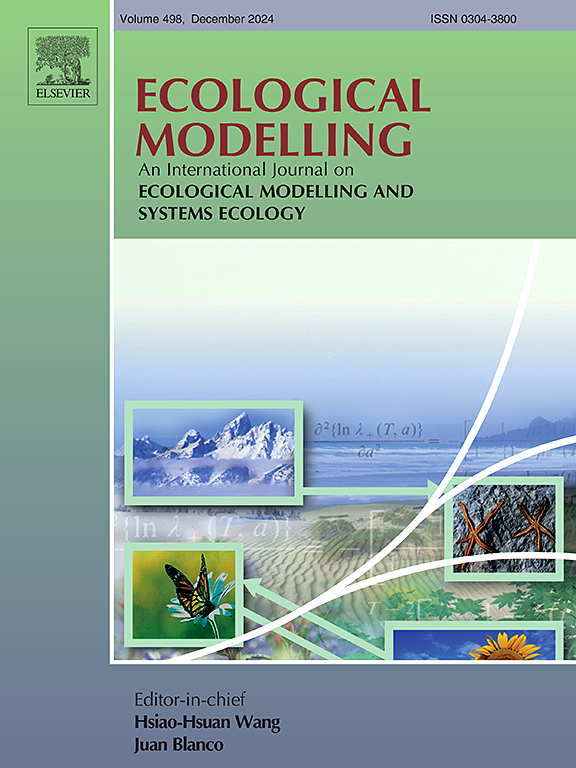Evaluating the Dynamics of Brazil's soybean trade: a comprehensive emergy analysis of resource dependencies
IF 3.2
3区 环境科学与生态学
Q2 ECOLOGY
引用次数: 0
Abstract
This study examines Brazil's soybean trade through the dual lens of economic and environmental considerations, employing emergy synthesis to reveal hidden resource dependencies and costs within production and export processes. It bridges ecological modeling and sustainability science by analyzing Brazil's soybean trade through the interplay of economic and environmental dimensions. By applying emergy-based indices—such as the Emergy Exchange Ratio, Emergy Benefit Ratio, and Opportunity Ratio - the analysis offers a nuanced understanding of trade dynamics between 2015 and 2019, particularly with partners like China and Europe. The trade with China showed an average EER of 0.27, meaning that for every unit of emergy value Brazil exported in raw soybeans, it received substantially more emergy in currency terms. In comparison, trade with European partners, such as Spain and The Netherlands, with EE>1, was notably unfavorable for Brazil. The Opportunity Ratio is another key metric to indicate the potential economic gains from processing raw soybean commodities domestically. The analysis revealed that, on average, domestic processing could potentially lead to a GDP increase of 17 % from the soybean sector. Highlighting the environmental implications of reliance on non-renewable inputs such as fertilizers and pesticides, the study underscores the potential benefits of domestic soybean processing for enhancing GDP, reducing import dependency, and fostering equitable resource use. The research provides insights into sustainability through carefully integrating economic and ecological perspectives, informing strategies for addressing environmental costs while fostering balanced global trade practices.
评估巴西大豆贸易动态:资源依赖的综合能源分析
本研究通过经济和环境考虑的双重视角考察了巴西的大豆贸易,利用能源综合揭示了生产和出口过程中隐藏的资源依赖和成本。它通过经济和环境维度的相互作用分析巴西的大豆贸易,将生态模型和可持续性科学联系起来。通过应用以能源为基础的指数,如能源交换比、能源效益比和机会比,该分析提供了对2015年至2019年贸易动态的细致理解,特别是与中国和欧洲等合作伙伴的贸易动态。与中国的贸易显示,平均能源效益为0.27,这意味着巴西出口的每单位原大豆的能源价值,以货币计算,它获得的能源价值要多得多。相比之下,与欧洲伙伴(如西班牙和荷兰)的贸易对巴西明显不利。机会比是另一个衡量国内大豆原料加工潜在经济收益的关键指标。分析显示,平均而言,国内加工可能会使大豆部门的国内生产总值增加17%。该研究强调了依赖化肥和农药等不可再生投入对环境的影响,强调了国内大豆加工对提高国内生产总值、减少进口依赖和促进公平利用资源的潜在好处。该研究通过仔细整合经济和生态观点,为解决环境成本的战略提供见解,同时促进平衡的全球贸易实践。
本文章由计算机程序翻译,如有差异,请以英文原文为准。
求助全文
约1分钟内获得全文
求助全文
来源期刊

Ecological Modelling
环境科学-生态学
CiteScore
5.60
自引率
6.50%
发文量
259
审稿时长
69 days
期刊介绍:
The journal is concerned with the use of mathematical models and systems analysis for the description of ecological processes and for the sustainable management of resources. Human activity and well-being are dependent on and integrated with the functioning of ecosystems and the services they provide. We aim to understand these basic ecosystem functions using mathematical and conceptual modelling, systems analysis, thermodynamics, computer simulations, and ecological theory. This leads to a preference for process-based models embedded in theory with explicit causative agents as opposed to strictly statistical or correlative descriptions. These modelling methods can be applied to a wide spectrum of issues ranging from basic ecology to human ecology to socio-ecological systems. The journal welcomes research articles, short communications, review articles, letters to the editor, book reviews, and other communications. The journal also supports the activities of the [International Society of Ecological Modelling (ISEM)](http://www.isemna.org/).
 求助内容:
求助内容: 应助结果提醒方式:
应助结果提醒方式:


